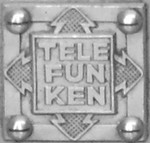

Fahrbar Leichte Funkstation 19/25
Funken - Kleinstation GFuk 18
Telefunken GmbH, Berlin / Telefunken AG, Zürich



|
Fahrbar Leichte Funkstation 19/25
|

|
|
überarbeitet am 6.1.2015 |
After World War I, the Swiss Army needed to purchase new equipment for "spark telegraphy",
because of a lack of funds (Switzerland was quite a poor country with an economy
mainly based on agriculture, then), the Signal Command decided to buy a number
of six wireless stations on single axed horse driven limbers.
In 1919, six stations "Funken - Kleinstation GFuk18" (Spark small station GFuk18)
have been orderen from the German "Deutsche Gesellschaft für drahtlose Telegraphie, Berlin"
(German society for wireless telegraphy), the later "Telefunken" company. In the first years, the transmitter used was a Telefunken Löschfunkensender 0,4 TV
(Telefunken Sparc Gap transmitter 0,4 TV) for telegraphy B2. This could be tuned in
the 187,5 - 2000 kHz range, the nominal output power was 400 W, primary power 1000 W. When the signal troops equipment was renewed in the year 1925, the existing
F.L.19 stations were improved and ten new stations were ordered: The transmitter
with the new arrangement was a Telefunken valve transmitter Zwischenkreissender ARS 87
for telegraphy A1 (CW), A2 and makeshift telephony A3. The transmitter covers the
187,5 - 790 kHz frequency range and has an output power 75 W.
In the early setup, the receiver used was a Audionempfänger E213a
(Tuned radio frequency with regeneration) covering the 86 kHz - 2000 kHz frequency range,
in this receiver, two triode valves RE 11 are used. The aerial used was a umbrella antenna on a15 m telescopic mast mounted
on the back trailer or a 60 m T or L shaped double wire antenna erected between
two 12 m masts. The station was powered from a fuel operated generator. The "Fahrbar Leichte Funkstation 25" has been finally replaced by the FL 40,
constructed by Zellweger, Uster in the year 1941 and want completely out of service after the
end of World War II general mobilisation. further reading: © 6.1.2015 Martin Bösch |